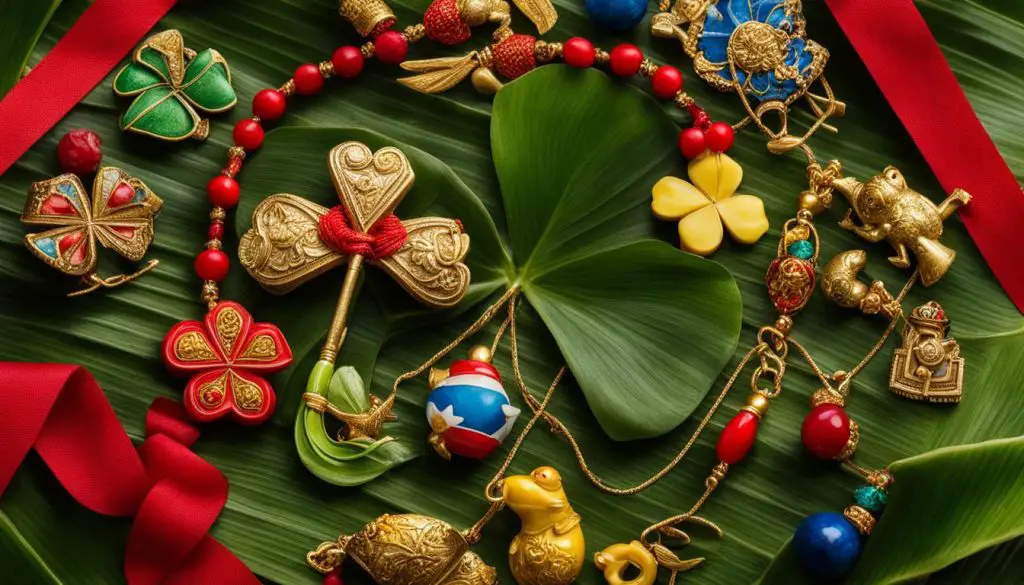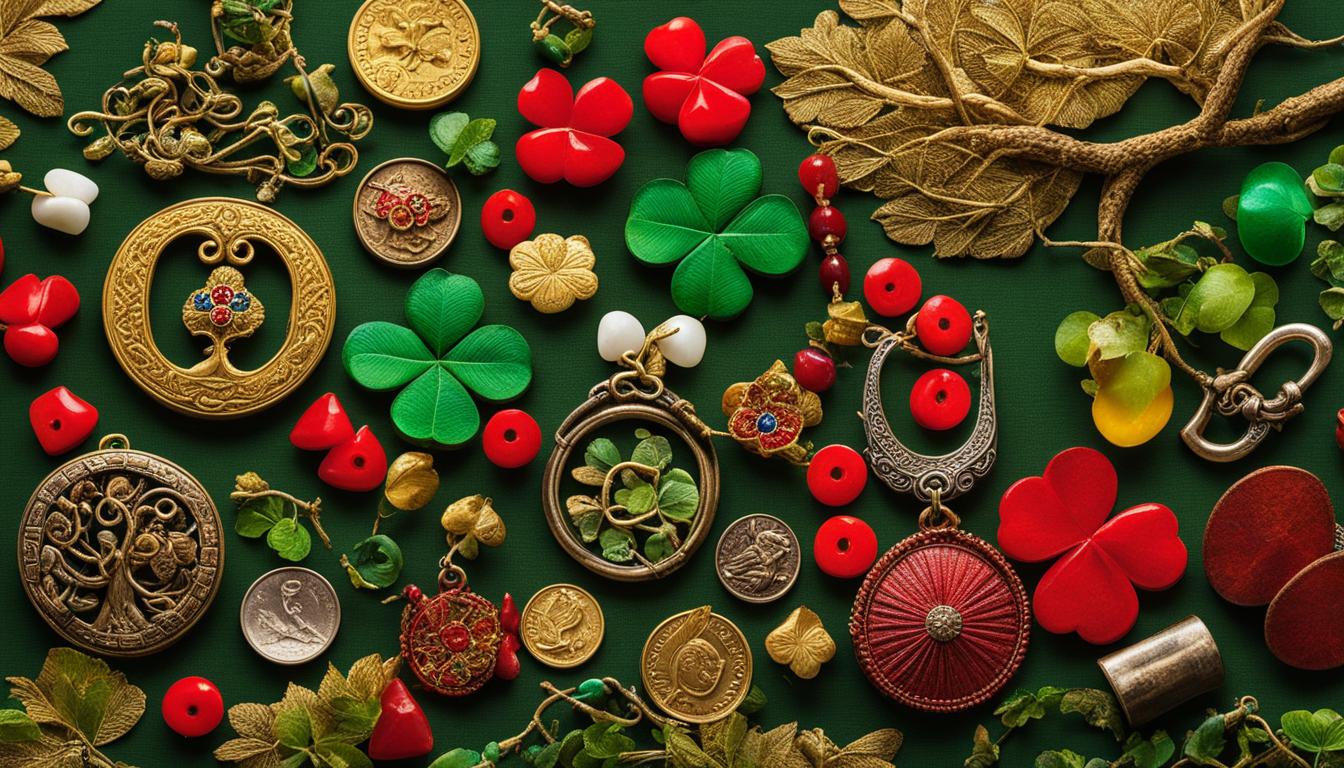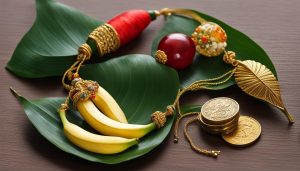The Philippines is a country with a rich history of colonization, which has influenced its customs and traditions, including beliefs about good luck. The Filipino culture is a mix of Animist, pre-colonial beliefs with Hindu-Buddhist influences, as well as Christian traditions. Filipinos have various superstitions and beliefs that they strongly adhere to in order to attract good luck and avoid bad luck. These beliefs are deeply ingrained in their daily lives and play a significant role in their cultural identity.
Contents
- 1 Superstitions for Good Luck in Filipino Culture
- 2 Filipino Customs and Traditions for Good Luck
- 3 Unique Filipino Beliefs and Cultural Superstitions
- 4 Cultural Representations of Filipino Beliefs
- 5 Filipino Culture and its Impact on Daily Life
- 6 Conclusion
- 7 FAQ
- 7.1 What are some superstitions for good luck in Filipino culture?
- 7.2 What are some Filipino customs and traditions for attracting good luck?
- 7.3 What are some unique Filipino beliefs and cultural superstitions?
- 7.4 How do Filipino beliefs and traditions represent their cultural identity?
- 7.5 How does Filipino culture impact daily life?
- 8 Source Links
Key Takeaways:
- Filipinos have superstitions and cultural practices to attract good luck.
- Beliefs and customs such as lucky charms and serving pancit at celebrations are deeply rooted in Filipino culture.
- Unique Filipino beliefs, like “pwera usog” and “pagpag,” reflect their strong belief in luck and cultural identity.
- Understanding Filipino culture is essential to appreciate and respect their beliefs and traditions.
- Filipino culture is deeply intertwined with daily life, shaping behavior and decision-making.
Superstitions for Good Luck in Filipino Culture
Filipinos have a rich tradition of superstitions and cultural practices believed to attract good luck. These customs are deeply rooted in their cultural identity and are still widely observed today. Here are some fascinating superstitions that Filipinos believe can bring good fortune:
The Number of Steps on a Staircase
According to Filipino belief, the number of steps on a staircase at home should not be divisible by three. Ending on the third step is considered unlucky. This superstition stems from the belief that evil spirits move in straight lines, so having a staircase that breaks this pattern can help ward off bad luck.
Turning Plates When Someone Leaves a Meal
Another interesting superstition is the act of turning plates when someone leaves in the middle of a meal. It is believed that by doing this, you ensure the safe travels of the person leaving. This practice reflects the Filipino value of showing care and concern for loved ones wherever they may be.
The “Pagpag” Ritual
The “pagpag” ritual is a belief that one should not go straight home after attending a wake. This is to avoid bringing the spirit of the deceased home. Instead, Filipinos go to a different location, such as a restaurant or mall, to shake off any spiritual residue. This superstition shows the deep respect Filipinos have for the deceased and their desire to protect their homes from negative energy.
| Superstition | Description |
|---|---|
| Number of Steps on a Staircase | The number of steps on a staircase should not be divisible by three to avoid bad luck. |
| Turning Plates When Someone Leaves a Meal | Turning plates when someone leaves in the middle of a meal ensures their safe travels. |
| The “Pagpag” Ritual | Avoid going straight home after a wake to prevent bringing the spirit of the deceased home. |
These superstitious beliefs and practices are just a glimpse into the rich tapestry of Filipino culture. They highlight the importance of luck and the efforts Filipinos make to invite positive energy into their lives. By understanding and appreciating these traditions, we gain a deeper appreciation for the cultural diversity of the Philippines and the values that shape Filipino society.
Filipino Customs and Traditions for Good Luck
Filipinos have a rich tradition of customs and beliefs centered around attracting good luck and fortune. These cultural practices are deeply ingrained in Filipino society and reflect their strong belief in the power of luck. One such practice is the use of lucky charms, known as “anting-anting.” These amulets are believed to protect the wearer from harm and bring good fortune. Common examples include religious objects like crucifixes or statues of saints, which are often carried or worn as a form of spiritual protection.
Another widely observed tradition is the serving of pancit, a type of noodle dish, at special celebrations. Pancit is believed to symbolize long life and prosperity, and its presence at birthdays and other important events is seen as a way to attract good fortune for the honoree. This practice showcases the importance of food in Filipino culture and the cultural significance placed on the symbolism of certain dishes.
Filipinos also hold a deep respect for elemental creatures and supernatural beings. When passing through places believed to be inhabited by these creatures, such as secluded forests or ancient trees, it is customary to say “tabi tabi po” as a sign of respect and to avoid any potential negative encounters. This reflects the belief in the existence of a spiritual realm and the importance of maintaining harmony and balance with the supernatural.
Lucky Charms in Filipino Culture
Lucky charms play a significant role in Filipino culture and are believed to bring good fortune and protect against bad luck. These charms can take various forms, including religious symbols, objects from nature, or personal artifacts. Here are some commonly used lucky charms in Filipino culture:
- Agimat: A Filipino amulet or talisman believed to possess magical powers and provide protection.
- Bahay Kubo: A miniature model of a traditional Filipino house, symbolizing prosperity and abundance.
- Elephant figurines: Elephants are seen as a symbol of good luck and wisdom in Filipino culture.
- Horseshoes: Considered to bring good luck and protect against evil spirits when hung above a doorway.
Traditional Practices for Good Fortune
Unique Filipino Beliefs and Cultural Superstitions
Filipino culture is filled with unique beliefs and cultural superstitions related to luck. These beliefs and superstitions reflect the deep connection Filipinos have to their culture and their strong belief in the power of luck. Let’s explore some of the popular beliefs about luck in the Philippines and the customs for attracting good fortune.
Beliefs on Baby Fondness and Illness
In Filipino culture, showing fondness over babies without saying “pwera usog” can potentially cause illness to the child. This is a common belief that has been passed down through generations. It is believed that when someone shows excessive affection towards a baby and doesn’t say “pwera usog,” they can inadvertently transfer their negative energy and cause harm or illness to the child. This belief highlights the importance of warding off negative energy and protecting the well-being of children.
Blaming Missing Things on “Dwendes”
Filipinos have a curious belief when it comes to missing items. They attribute the disappearance of things to playful elves called “dwendes.” These mischievous creatures are believed to take things and hide them, causing frustration and confusion for the person who lost them. Filipinos often use this belief as a lighthearted explanation for missing items, providing a bit of folklore and mystery to everyday life.
Avoiding Trying on Wedding Dresses
Another unique belief in Filipino culture is related to weddings. Many Filipinos believe that not trying on the wedding dress before the big day brings good luck and prevents the cancellation of the union. This belief stems from the idea that trying on the dress before the wedding may invite bad luck or negative energy that can lead to a failed marriage. To maintain a positive outlook and ensure a successful union, brides-to-be adhere to this cultural superstition.
| Belief | Description |
|---|---|
| Baby Fondness and Illness | Showing excessive affection towards a baby without saying “pwera usog” can potentially cause illness to the child. |
| Blaming Missing Things on “Dwendes” | The disappearance of items is attributed to mischievous elves called “dwendes” who take and hide things. |
| Avoiding Trying on Wedding Dresses | Not trying on the wedding dress before the big day is believed to bring good luck and prevent the cancellation of the union. |
These unique beliefs and cultural superstitions showcase the rich tapestry of Filipino culture. They serve as a reminder of the deeply ingrained traditions and the importance of luck in the lives of Filipinos. These beliefs are passed down through generations and continue to play a significant role in shaping behavior and decision-making within Filipino society. By understanding and appreciating these cultural superstitions, we can gain a deeper insight into the customs and traditions that make Filipino culture so unique and vibrant.
Cultural Representations of Filipino Beliefs
Filipino culture is rich with unique customs and traditions that reflect the beliefs of the people. These cultural representations provide insight into the Filipino way of life and contribute to the development of stereotypes that are associated with the Philippines.
Traditional Clothing
One notable cultural representation is the traditional clothing worn by Filipinos. The national costume, known as the Barong Tagalog for men and the Maria Clara dress for women, showcases the elegance and craftsmanship of Filipino culture. These traditional garments are often worn during formal events, weddings, and cultural celebrations, and demonstrate the pride and appreciation Filipinos have for their heritage.
Bayanihan Spirit
The Bayanihan spirit is another cultural representation that showcases the strong sense of community and unity among Filipinos. This term refers to the practice of coming together as a community to help one another in times of need. It is often depicted through the image of a group of people carrying a traditional Filipino house or “bahay kubo” on their shoulders. This representation symbolizes the collective effort and cooperation that is deeply ingrained in Filipino culture.
Religious Festivals
Religious festivals, such as the Sinulog Festival in Cebu and the Ati-Atihan Festival in Aklan, are vibrant and colorful cultural representations that highlight the deep religious devotion of Filipinos. These festivals celebrate the country’s Christian heritage and are characterized by lively street processions, traditional dances, and intricate costumes. They serve as a reminder of the strong influence of religion in Filipino culture.
| Cultural Representation | Description |
|---|---|
| Traditional Clothing | The Barong Tagalog for men and the Maria Clara dress for women showcase the elegance and craftsmanship of Filipino culture. |
| Bayanihan Spirit | The Bayanihan spirit reflects the strong sense of community and unity among Filipinos, symbolized by the practice of carrying a traditional Filipino house on their shoulders. |
| Religious Festivals | Religious festivals like Sinulog Festival and Ati-Atihan Festival highlight the deep religious devotion of Filipinos, characterized by colorful street processions and traditional dances. |
These cultural representations not only serve as a source of pride and identity for Filipinos but also promote the rich diversity of the country’s traditions and customs. They contribute to the understanding and appreciation of Filipino culture by showcasing the unique characteristics that make the Philippines truly one-of-a-kind.
Filipino Culture and its Impact on Daily Life
Filipino culture is a dynamic tapestry that weaves into the fabric of daily life. The customs, traditions, and beliefs of Filipinos shape their interactions, celebrations, and decision-making processes. At the core of Filipino culture are values such as hospitality, teamwork, adaptability, humor, and strong family ties. These values guide Filipinos as they navigate their daily lives, creating a unique character and identity.
One notable aspect of Filipino culture is the emphasis on hospitality. Filipinos are known for their warm and welcoming nature, often going out of their way to make guests feel comfortable. Respect for elders and the act of taking care of one another are deeply rooted in Filipino customs. It is common for extended families to live together and support each other emotionally and financially.
Teamwork and adaptability are also integral to Filipino culture. Filipinos place great importance on collaboration and working together towards a common goal. This is evident in the strong sense of community found in Filipino neighborhoods and the practice of “bayanihan,” where neighbors come together to help move a house or assist in times of need. Adaptability is another key trait, as Filipinos have learned to navigate challenges and embrace change due to the many influences that have shaped their culture over centuries.
Beliefs and superstitions also play a significant role in Filipino daily life. Filipinos embrace a rich tapestry of traditional beliefs and practices that are passed down through generations. These beliefs range from lucky charms and superstitions to respect for elemental creatures and spirits. For example, the use of lucky charms like the “anting-anting” and the practice of saying “tabi tabi po” when passing through places believed to be inhabited by these creatures reflect the deep-rooted belief in attracting positive energy and warding off negative influences.

The impact of Filipino culture on daily life is undeniable. It shapes the way Filipinos interact with others, celebrate special occasions, and make important decisions. Understanding and appreciating the customs, traditions, and beliefs of Filipinos is essential for fostering cultural diversity and promoting intercultural understanding. Filipino culture is a beautiful tapestry that continues to evolve and thrive, with each thread contributing to the vibrant fabric of Filipino identity.
Conclusion
The Filipino culture is a tapestry of diverse traditions, customs, and beliefs that have been shaped by a rich history of colonization and a fusion of indigenous, Hindu-Buddhist, and Christian influences. Superstitions and beliefs about luck are deeply woven into the fabric of Filipino culture, influencing daily life and practices. These cultural values and practices, such as hospitality, teamwork, adaptability, and strong family ties, contribute to the unique cultural identity of Filipinos.
Understanding and appreciating Filipino culture is crucial for fostering cultural diversity and promoting intercultural understanding. The Philippines is home to a multitude of ethnic groups, each with its own distinct customs and traditions. Embracing this cultural diversity allows for a deeper appreciation of the Filipino people and their rich heritage.
From the superstitions surrounding staircase steps and the serving of pancit at celebrations to the use of lucky charms and the belief in elemental creatures, these cultural practices reflect the deep-rooted belief of Filipinos in the power of luck and positive energy. By recognizing and respecting these beliefs, we can develop a greater understanding of Filipino culture and nurture a more inclusive society that celebrates diversity.
Embrace the Cultural Diversity and Cultural Identity of Filipinos
As we continue to strive for a more interconnected world, it is essential to recognize and embrace the cultural diversity and cultural identity of Filipinos. By valuing their unique customs, traditions, and beliefs, we can foster a sense of unity and promote a society that celebrates the richness and vibrancy of different cultures. Through cultural exchange and understanding, we can break down barriers and build bridges that connect us all.
FAQ
What are some superstitions for good luck in Filipino culture?
Filipinos believe that the number of steps on a staircase at home should not be divisible by three to avoid bad luck. They also turn their plates when someone leaves in the middle of a meal to ensure safe travels. “Pagpag” is the belief that one should not go straight home after attending a wake to avoid bringing the spirit of the deceased home.
What are some Filipino customs and traditions for attracting good luck?
Filipinos use lucky charms like “anting-anting” (amulets) or religious objects such as crucifixes or statues of saints for protection and good fortune. They also serve pancit (noodles) at celebrations, especially birthdays, as a symbol of long life. Filipinos say “tabi tabi po” when passing through places where elemental creatures are believed to dwell, showing respect and to avoid any negative encounters.
What are some unique Filipino beliefs and cultural superstitions?
Filipinos believe that not saying “pwera usog” when showing fondness over babies can potentially cause illness to the child. They blame missing things on playful elves called “dwendes” and attribute unexplainable discomfort to greetings from people with strong energy, known as “usog” or “bati.” Many Filipinos believe that not trying on the wedding dress before the big day brings good luck and prevents the cancellation of the union.
How do Filipino beliefs and traditions represent their cultural identity?
Filipino beliefs and traditions showcase their connection to their culture and their strong belief in the power of luck. Turning plates when someone leaves a meal represents their belief in safe travels, while the use of lucky charms and serving pancit at celebrations reflects their desire for good fortune and long life. These cultural representations also contribute to the formation of Filipino stereotypes.
How does Filipino culture impact daily life?
Filipino culture is deeply intertwined with daily life. Customs, traditions, and beliefs shape the way Filipinos interact with others and celebrate special occasions. Filipino values such as hospitality, teamwork, adaptability, humor, and strong family ties guide their behavior and decision-making. Regionalism and a strong sense of pride in one’s own region also play a significant role in daily life.






